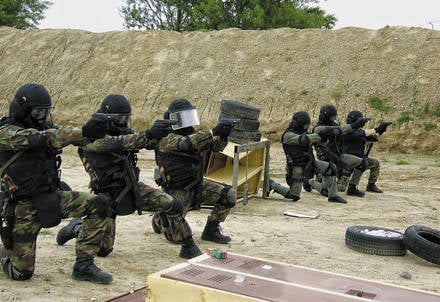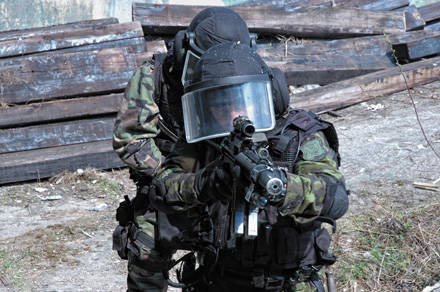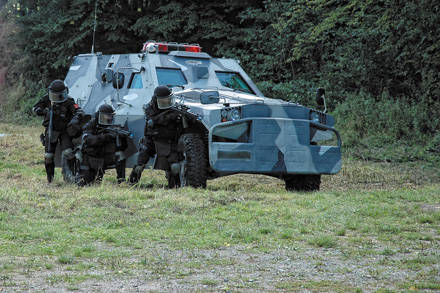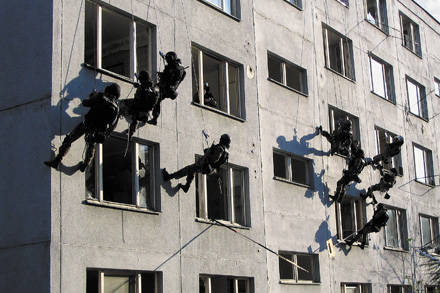"Lynx" - anti-terror in Slovak
 The Slovak Republic originated after the collapse of the former Czechoslovakia. It is inhabited by both Slovaks and Czechs. Today it is a member of the NATO bloc and is part of the European Union. However, besides the political and economic dividends, the withdrawal from the socialist camp also brought a whole range of problems that the Slovaks had previously only had to guess - this is about organized crime and the mafia.
The Slovak Republic originated after the collapse of the former Czechoslovakia. It is inhabited by both Slovaks and Czechs. Today it is a member of the NATO bloc and is part of the European Union. However, besides the political and economic dividends, the withdrawal from the socialist camp also brought a whole range of problems that the Slovaks had previously only had to guess - this is about organized crime and the mafia.In order to successfully combat these threats, a counter-terrorism unit has been created in Slovakia, called the UOU.
The group’s employees, although not part of special units known throughout the world (such as GSG-9, SAS, SEALs, etc.), nevertheless have quite decent professional training, modern armament and special equipment for carrying out assigned tasks. And most importantly, LYNX has considerable experience in real action to apprehend dangerous armed criminals and members of organized criminal groups.
Slovak Special Forces have a certain experience of participation in operations to free hostages. One of these episodes occurred in 2003 in the city of Kaplna, where LYNX, in collaboration with the police forces from the city of Trnava, neutralized a dangerous criminal who had killed three people and held four more people hostage. Thanks to the coordinated and professional actions of the Slovak special forces, the murderer was arrested, and all the hostages were released.
 Forming a group
Forming a groupThe prototype for LYNX was a special unit of the former Czechoslovakia called the URNA. The socialist government of Czechoslovakia decided that the state should have an elite group of police capable of successfully combating any kind of armed crime. The URNA group was formed in 1980 year as part of the 13 administration of the Czech law enforcement agency.
At the turn of the 1990-ies in Slovakia, organized crime has increased markedly. In this regard, it was decided that a rapid reaction police unit (like SWAT - special weapons attack team - in the USA) should be formed in the republic in order to cope with this newly emerging problem, as the Prague URNA group has the ability to counteract the criminal surge not enough.
Police rapid response unit was born in Bratislava 1 February 1991 of the year. His first commander was Col. Josef Maitan. In 1999, he was replaced by Lieutenant Colonel Igor Matyashovski.
After the collapse of Czechoslovakia and the emergence of 1 in January of 1993, the new state of Slovakia, the rapid response team from Bratislava took over the functions of the federal special forces unit URNA. However, the anti-terrorism functions were removed from the group’s tasks, since such emergencies practically did not occur in Slovakia. At the same time, the task of tough opposition to armed crime remained and became the main one. It is worth noting that the majority of URNA employees - almost 70 percent - were Slovaks by nationality. Therefore, having left the former federal unit, they formed the backbone of the Bratislava special unit.
In the period between 1991 and 1996, the structure of the group looked as follows: command, planning and analysis unit, training unit, unit providing for the transfer of special forces to the place of execution of tasks, quick response section consisting of two anti-terrorist teams, four special forces groups, a sniper team, assault team and dog team.
Soon, the Slovak Special Forces had to solve the first serious problem. In 1993, several people were taken hostage. They were held in the building of a furniture factory in Bratislava. The police managed to resolve the situation through negotiations, but the special forces group was in place a few minutes after receiving the signal and was ready to apply the most stringent measures to the criminals.
By the middle of the 1990-s, the crime rate in Slovakia had increased, and a new threat arose before the state - international terrorism. In 1996, the Slovak police underwent a significant structural reorganization, which did not bypass the group.
The new structure included a command, a logistics support section and an operational section. The logistic section consisted of an analysis unit, a branch of specially trained drivers and an administrative unit. The operational section consisted of four anti-terrorist teams, one training department, a dog training unit and a documentation department. Each of the anti-terrorist teams consisted of two teams (assault and support) for 5 people. Each member of the team is a universal fighter and is able in an extreme situation to replace his friend, which expands the combat capabilities of the group. In general, the anti-terrorist team consists of a commander, his deputy, two drivers, 3 – 4 snipers and 10 fighter-attack aircraft.
The transformation of the division entailed a change in its name. 1 May 1997, it became known as - by the European classification - LYNX Commando. The commander of the group was Lieutenant Colonel Jan Rade, under his command serve about 100 employees.
One team is always on standby for immediate action. Fighters can leave the base within 30 minutes after receiving an alarm. All equipment and equipment is packed in special containers that are immediately loaded onto vehicles that deliver operatives to the place of operation. If necessary, the duty unit is reinforced by another operational team, ready to use within a few hours after the alarm is announced. The third team assembles and takes action during 24 hours, etc. For this reason, the majority of LYNX employees live in barracks at the base or in its vicinity. Commands change on duty every 14 days. One of the LYNX teams is currently in Iraq, where it ensures the security of the Slovak Embassy.
 Tasks
TasksThe main task of the LYNX group is to fight terrorists and kidnappers, dangerous armed criminals, organized criminal communities and mafia structures.
The unit is also involved in the following tasks:
- participation in repelling possible terrorist attacks at strategic sites (nuclear power plants, dams, chemical plants, government buildings, etc.);
- elimination of the consequences of major industrial accidents and large-scale natural disasters;
- Ensuring the security of foreign statesmen during their visits to Slovakia;
- conducting joint training with other special forces from the European Union and NATO countries on the territory of the Slovak Republic.
LYNX is also responsible for the special training of employees of the Slovak National Police (descent on the rope, rock climbing, alpine training, parachuting, etc.). In addition, Slovak Special Forces assist in training police officers for peacekeeping missions, escort large amounts of money for transportation for the Slovak National Bank, ensure the safety of Slovak diplomatic missions abroad, assist the police in escorting extremely dangerous prisoners when they are brought to court or jail .
The group is quite often used to combat illegal migration and crimes related to trafficking in persons, drugs and vehicle theft. These types of crime appeared in Slovakia after the fall of the Berlin Wall in 1989. Mafia structures of some countries of Eastern Europe and the Balkan Peninsula also pose a great threat to Slovakia.
 Training
TrainingIn order for employees to acquire the necessary skills to successfully complete all assigned tasks, they undergo an intensive training course. Only volunteers over the age of 23 are accepted into the group. In this case, the candidate must have at least three years of service in the Slovak National Police or five years of service in the armed forces. Previously, the requirements for admission were more stringent: in LYNX only police officers were taken. However, this rule was later changed: it became possible to become a special forces antiterrorist group after serving in the armed forces, with preference given to candidates from the special forces regiment or battalion to eliminate the consequences of emergency situations. Such a decision was a forced step, because at a certain stage the group began to lack candidates who were ready to study spetsnaz science hard, and by becoming a current employee of LYNX, to risk their lives in carrying out dangerous tasks.
Requirements for candidates for admission to the subdivision are in many respects similar to those in the special forces of any other country: emotional stability, desire and ability to work in a team, good health. All applicants for service in LYNX must have a secondary education, be excellent swimmers, confidently drive a car. The qualifying course is held twice a year and includes four stages.
First of all, candidates are tested for their motivation to serve in special forces. This is one of the key aspects of admission to the group, because all its activities are associated with a high risk to life. Then follow special medical examinations, where the state of health, reaction rate, physical strength and endurance are checked. At the second stage, candidates pass various physical tests: running on 100, 1000 and 3600 meters, lifting hands on a rope to a height of five meters, long jumps, swimming for short and long distances.
The third stage of selection includes psychological and intellectual tests. Finally, the fourth stage of the qualifying course is called Hell Week.
During 7 days, candidates can sleep for a total of only about 30 hours in order to find out what their reaction is under stress and fatigue. It is important to note that in the last two days, tests are conducted as part of a group of 5 people. In this case, everyone must show a positive result, otherwise the group is considered liquidated. During the week, candidates participate in force-marches in body armor and with a backpack weighing 15, and then 30 kilograms.
Successfully passed the selection proceed to the next stage of training, that is, the main course of training in the framework of the training group. The team of instructors is tasked with teaching candidates all that is necessary to know and be able to successfully combat terrorism.
The basic training course lasts from 4 to 6 months. At this stage, candidates learn special operations tactics, various types of shooting (precision, instinctive, selective), rock climbing and fighting in the mountains, martial arts, mine explosives, assault techniques, swimming and scuba diving, parachuting, topography, communications , the use of special equipment available in the group’s arsenal, high-speed driving. Only after mastering these skills do candidates gain admission to operational groups.
Parachute training is carried out for seven days on the basis of the 5 regiment of the special purpose of the Slovak army. From a technical point of view, teamwork with helicopter crews is one of the most important elements of the special training of the LYNX unit. In the course of her candidates learn to parachute from helicopters in various ways.
Candidates who successfully complete basic training (and no more than 25 percent of the original number of such people are recruited) are given the opportunity to join the unit. However, this does not mean that they become full-fledged employees. Beginners are attached to task forces in order to familiarize themselves with the practical work of special forces. At first, new arrivals to the group take part in special events as observers or are included in the supporting units. After some time, with the accumulation of combat experience, they gradually begin to participate in real actions.
While serving in the unit, new members continue their training by attending various courses, with each receiving his own individual specialization: a dog handler, a sniper, a diver, a specialist in the use of explosives, a negotiator, and a driver. Some employees undergo an in-depth three-week parachute training course to become a qualified specialist in owning wing parachutes (HAHO / HALO). Others have been learning to dive in a small lake in the vicinity of Bratislava for two weeks.
The group pays great attention to the level of fire training of employees. All special forces practice shooting several times a week, and snipers every day.
Cooperation
In order to exchange experience, the LYNX group closely interacts with similar units of other law enforcement agencies of Slovakia, as well as foreign countries. The division is a member of the ATLAS organization, which includes anti-terrorism units of law enforcement agencies of the EU countries. ATLAS was established to achieve a high level of international cooperation in the fight against terrorism.
Slovak Special Forces have good contacts with colleagues from such well-known special units as the Italian GIS, the French divisions of RAID and GIGN, the Hungarian group TESZ, the Czech URNA, the German GSG-9. LYNX also maintains excellent relations with the Austrian anti-terror group Cobra.
 Armament and equipment
Armament and equipmentLYNX employees are equipped with the most modern weapons and equipment, like all similar Western units of this kind, which allows them to successfully cope with various emergency situations.
Personal weapons are mainly represented by models from the world's most famous manufacturers. The group is armed with excellent Swiss SIG P-226 pistols, Austrian Glock-17 pistols of 9 mm caliber, as well as Czech CZ-75 and CZ-85 pistols of the same caliber. In addition, employees use a small number of Smith & Wesson revolvers.
During assault operations, the special forces use German Heckler und Koch MP-5 assault rifles of various modifications, including those with a built-in silencer. They also use the Belgian FN P90 5,7mm submachine gun. In recent years, for the needs of the group, a small number of SIG Sauer 551 SWAT and H&K G-36 K assault rifles were purchased, on which an AG-36 grenade launcher can be installed. Also in the arsenal of LYNX there is a Czech 58 mm Vz.7,62 V rifle, which is used mainly in the training process or when an operation requires the use of a weapon of higher firing power.
Snipers use a Swiss-made SIG Sauer SSG 3000.308 Winchester sniper rifle (7,62 x 51 NATO) with a manual shutter, as well as the well-known semi-automatic Dragunov sniper rifle of 7,62 mm. It is important to note that in the course of their training, snipers work out the ability to hit a remote target from the first shot. Hensoldt or Simrad Optronics devices of Norwegian production are used as optical sights. They are usually mounted on SSG 300 rifles. When the situation requires the use of weapons of increased power and firing range, the Accuracy International.50 BMG English sniper rifle is used.
The group's arsenal also includes H&K GP-69 grenade launchers, Benelli Nova and Winchester Defender 1300 12mm shotguns.
During the assault on objects, the group uses plastic explosives from Slovak production, various types of detonators, stun grenades and police grenades with an irritant gas, assault ladders and special equipment for entering the premises.
In the fleet of the unit there are various modifications of automobile and armored vehicles of world famous manufacturers: passenger cars Volkswagen, Skoda, Opel, SUVs Mercedes Benz ML320, Hummer, Land Rover Discovery, armored personnel carriers Aligator. For air operations, Mi-2, Mi-8/171 helicopters included in aviation Slovak Police Group headquartered in Bratislava.
As for personal equipment, it includes camouflage Vz 97 suits and black VEP Bojnice Comfort overalls from Slovak production using modern Nomex and Gore-Tex materials. Slovak commandos have no problems with equipping them with special shoes (including the so-called "quiet" soles), tactical gloves, knee pads and elbow pads, masks, hiding the face.
All employees wear a tactical “unloading” vest when carrying out operations, on the back of which the inscription “Policia” is inscribed in large letters. Special Forces, if necessary, use an American gas mask M-95.
The group attaches great importance to the personal protection of employees against bullets and shrapnel. They are equipped with French tactical glasses that protect the eyes during the assault, as well as German body armor Mehler Vario System GmbH with 3-th and 4-th level of protection. The head of the staff is protected by the Austrian titanium Ulbrichts AM95 helmet with built-in headphones. LYNX employees can also use Bell lightweight helmets.
In addition, the armament of the group consists of various systems for scuba diving, parachuting, actions in the mountains of local and foreign production.
- Zoran Milosevic
- http://www.bratishka.ru"rel =" nofollow ">http://www.bratishka.ru
Information